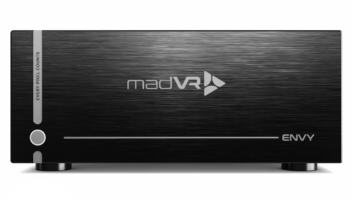Another notable residential electronic systems contractor has made the leap from integration to manufacturing. Industry veteran, Mike Pyle, former owner of Aurant in Draper, Utah, is the latest dealer to come up with an out-of-the-box product concept intended to simplify the complicated nature of custom installation. SE2 Labs will soon ship the first model of its ITC One (Integrated Theater Console), which has already garnered a CES Best of Innovations 2008 award in the Integrated Home Systems category, to dealers. With each ITC One, custom installers or end users design a personalized system from the SE2 Labs website. Each ITC One is then built and shipped within two weeks. The following components can be included: Microsoft X-Box 360, X-Box 360 HD DVD Player, Nintendo Wii, DirecTV, HD TiVo, Dish Network DVR, national cable provider’s DVR (including Comcast, Time Warner, Cox Cable), AMX Netlinx Control System, high-end digital surround processor, Bryston pre-amp processor with full digital outputs, IcePower high-end D-class amplifiers, high-end video processor, front touchpanel screen, Apple video iPod with dock, proprietary remote control, power conditioning, Transparent cabling and cable harness, and an anti-noise and vibration system–all integrated through a clever design and in a relatively compact box. Pyle took a moment to explain to RS where his idea came from and why his company is built to last.SE2 Labs Mike Pyle and his ITC One
As a custom installer, was manufacturing an area that you were always interested in exploring or did this project come along in a different way?
It was kind of a process of evolution. At Aurant, we became pretty efficient at pre-building or pre-assembling systems. We were able to completely design, build, and test a system in house. We did this because most of our big projects were out of state. We had to do all of the heavy lifting here, and then do this final plug-and-play installation on the jobsites. After a couple of years we got to the point where we could actually build more systems than we could sell or manage. That’s when we started a company called ACS (Audition Contract Systems) where we sold pre-packaged systems to other dealers. That was just a way to keep our pre-assembly side of the business busy. That went pretty well, but it often became a sales challenge because we had to hold the hands of all of these dealers who wanted to get in and customize everything and change things. Really what we wanted to offer were these turn-key packages that were all ready to go. We also found that a lot of these dealers wanted a complete turn-key theater system.
Give me an example of what you mean.
Take for instance a 15,000-square-foot house, you usually have the theater, the living room, the master bedroom, the kitchen, that all need a little audio/video subsystem. So we started building all of these racks that were kind of plug and play. A couple companies liked that concept so much that they started ordering just those by themselves and not really buying the whole-house systems. We looked at that and realized that there might be a market out there for taking semi-mass-production standardization and selling it to other dealers. It was pretty expensive, though.
Our next step was to build a rack system to hold all of the equipment, because that was the biggest cost when you looked at the whole price of the system. So we developed our own extruded aluminum rack rails and we had our own connection panel so the dealer would not have to do any inner-rack wiring; it was all just external plug and play. Then we built an vinyl-covered faceplate that went over the front of all of the components to clean up the look of. We showed that at CES in 2004. The dealers really liked it and the cost finally got down to where it made some sense. We realized that the average dealer out there didn’t have the sophistication to build these things sufficiently, and that opened up this opportunity. That’s when we had to decide if we were going to change Aurant to become a manufacturing business or would I start this thing on my own? I decided to go out on my own and get a clean start with manufacturing.
The other thing that was a big eye opener for us was that we went out and tested existing theaters, some of which we’d installed and quite a few that we didn’t. We found that the state of the actual installed theater was a disaster. There were major configuration errors–a lot of things you would think that a top-notch company would have taken care of. At the end of the day these guys are so dang behind just unboxing the stuff and plugging it in that when it comes to those final details, it just gets overlooked.
So this audio, video, everything?
Everything. It was across the board. For instance, on the majority of satellite receivers, no one had gone in and told it to output Dolby Digital, or we were still outputing 480p instead of 1080i. The big thing was that so many speakers were simply out of phase. We also did quite a bit with interviewing end-users, the families, to get a sense of what their experience was like with the system. That was definitely a mess. Generally the only one who said they liked the way it worked was the person who wrote the check and everyone else was like, “Man, this thing sucks.”
So this all came as a huge surprise, I would imagine.
Yes, especially when we could not find one customer who actually liked the touchscreen in the theater. Here we had been pushing a touchscreen purchase on every theater we had ever done. But when you think about it, who wants to sit and surf TV with a touchscreen in their lap, pushing on a button in space on this screen, right? It really opened our eyes to looking at what the end user really wants, not just what we wanted to sell.
What were the design priorities of the ITC One?
It was a long process. First we looked at how they technically integrated together, and then we looked at the different companies and also performance and reliability. We chose simplicity as our first priority. In fact, in the name SE2 Labs, SE2 stands for “super easy to…” so that’s to remind us to make something very simple. It also needs to be super easy to buy, to install, to use, to service, and to upgrade. Reliability was our next criteria. When we stepped back and looked at the original rack that we’d sold as ACS dealers, we decided to look at consumer electronics failures. What was making these things malfunction? Heat was by far the number one culprit for consumer electronics failures out there. It was something like 80 percent of all failures were heat related. So that was the first thing we set out to solve. When you look at it, you realize pretty quickly why it’s an issue–everything’s horizontal, the intakes and exhaust are usually at the same level so they short circuit because we’re just feeding it the heat that they pump back out, and when you put a series of components on a shelf or in a rack. As a result all of the boards internally in the ITC One are vertical. Then we have this intake plenum on the bottom that takes the air from below, pulls it up through the boards and exhausts at the top so now I can’t short circuit.
You’re using fans, I assume. What’s your answer to the fan noise challenge?
Exactly. We realized that it would be loud. So we built that bottom faceplate, plenum with a series of acoustical baffles that the air actually goes through, then there’s four, four-inch fans the air blow the air up through the vertical boards, then the air goes through another series of acoustical baffles on the exhaust. We’ve done a lot to attenuate the noise of not only the fans, but the airflow too. I’ve done high-end home theater my whole career and noise floor is a big deal. That’s what drove the architecture of the whole console. When you look at it, people don’t necessarily love the industry design. In fact, industrial design was way down the priority list for us. It was designed to function first, and because it functions so differently from a typical rack.
How did you select the manufacturers that fit into your integrated system?
We needed to find ones that built modular pieces. For instance, we don’t need a surround sound processor with video switching because we already had great video switching and a great video processor. That’s a pretty short list of companies whose product can be taken apart in a way that it can just be the audio portion. We really don’t want to re-engineer or re-develop a surround sound processor. We don’t want to do it and we don’t want to pay to have someone else do it. We wanted an off-the-shelf product that had been proven already. Bryston was pretty high on that list, and we used the MDS SSP board, which is the best out there. They have incredible analog discrete circuitry. It’s super reliable and they have a 20-year warranty on their stuff. So that was our first choice and fortunately we were able to seal that deal with them. Vidikron… I wanted the best video, and I didn’t want to have to explain how good our video was. With our relationship with them we were able to partner with them to get not only great video displays packaged with the system but the video scaler switcher board. Then for control systems we looked at simplicity and reliability. AMX was at the top of the list even though I’d been a Crestron guy for a long time. Crestron’s great and has a lot of really cool products, but AMX has great products as well and is a little bigger in the OEM kind of stuff. It’s very simple, robust stuff, so that’s why we leaned toward them. We’re taking off-the-shelf products that they’re building already and integrating. We wanted proven technology.
What’d you look for in power management?
Power was the second highest failure rate for components, so we wanted the best power conditioning, surge protection product we could get. We went with Transparent, who is much better known for its cable products. We got our hands on some of their products five or six years ago and they just looked and sounded amazing. They’ve also got great surge protection. So we went to those guys and had them take their product and re-package it for us and basically got their $2,000 power conditioner built on board. Same thing with the wire harness, which gives us a good signal path internally from board to board. So we just kind of went through and picked the best of the best. Fortunately because I’ve been in the industry for a while people knew who I was and that opened some doors.
How does this all get assembled?
Everything other than our amplifiers are built in North American. Our amplifiers come from Bang & Olufsen’s ICEpower, which produces a D-Class amplifier that is quite good. We do final assembly here at our place. A dealer goes online and says, “I want DirecTV, and I want this much power, and a video iPod dock and all of these other features. We can add a Wii or X-box or HD DVD driver. We can configure this thing and build it to order. It’s mass customization in that they can choose a list of features for a customer. We can take the customer information and we set up the satellite receiver, set up the Xbox with the account. We actually go through and configure everything. And if they buy a video display from us, then we get the video display, plug it into the system, do all of the calibration and burn the complete system in for 36 hours. When it ships out to the customer from here, it’s been totally debugged, burned in, configured, optimized and ships out in a handbuilt Roadie-type case. They just have to plug it in.
These are still selling through the dealer channel, but you are also marketing directly to consumers. How doe that work?
When a customer comes to us direct, we turn that customer over to the dealer. We’re launching our website where an enduser can go on, build a system and then that system gets forwarded to the dealer in that area. That dealer then contacts them, deals with the payment, and makes sure they’re configuring it right. Then the dealer actually activates it, pays for it, and we build it and ship it out.
So in addition to maintaining the integrity of our channel, the role of the dealer in that case is quality control?
There’s definitely an amount of work that somebody has to do to help set up a system. You want to make sure the speakers and projector are positioned correctly. We’re not taking the custom dealer out it. We’re just making it easier by plugging in one component instead of ordering from 10 different vendors, waiting until everything shows up, spend a week building the thing, testing it. It’s a week to two-week process just to actually install one of these high-end home theaters. We can get that down to a day. That’s really the idea.
So far, how would you describe the types of dealers that are already on board with you? Are some of them veterans that see the value in something like this or are they mostly new companies?
It’s a mix, but I’d say that the newer ones are definitely more open to change. It’s interesting. The guys who have been around for 15 or 20 years remember the days of selling high-margin simple product. You’d sell a high-end amplifier and most of the times just help the customer put it in his trunk. Even if you had to deliver it, you take it out of the box, plug it in and it was a $10,000 sale at 40 points and you were done. Most of those guys who went through that remember actually making money, then we all evolved into this custom thing where we have vans everywhere and programmers and racks of gear. All of a sudden it became less manageable and less profitable. The bottomline actually shrank. If you look at the average CEDIA dealer compared with the average PARA dealer back in the day, it’s not as profitable. Guys who remember that actually see this as a way to get back to those days when they could actually sell a lot of high-end, good quality product that the customer is going to be happy with and they’re going to make margin and get in and out quickly without a whole lot of headaches. Then you’ve got the guys who came into the business eight years ago and they kind of built their businesses on the custom side. These say, “Wait, why would I want to do all of this? This is where I’m making all of my margin.” The reality is that most of those guys haven’t paid attention to their P&L well enough to know that they’re not making what they think they are. We got sophisticated enough that we could look at what it was really costing us to build a $30,000 or $40,000 theater and the overall job margin was between 20 and 25 percent when it was all said and done with labor and ordering the parts. That’s good, but not great. And we were actually pretty sophisticated with it so I’m betting there’s a bunch of guys out there that are doing $40,000 theaters that are really making 10 or 15 percent and don’t even know it. The guys who really get what’s going on really don’t want to have to add 10 more vans next year to increase business. You even look at Best Buy and that’s kind of their bottleneck right now. The customers seem to get it faster than the dealer, because the dealer still thinks the customer wants this complex monster. Really, customers just want it to work, sound good, and be reliable.
Just to clarify, this is just a one-room solution?
Correct. Our initial goal was to work with the single media room, but we do have remote zone in/out and we have an RS232 port so you can control with an external control system. We have lighting for that single room. Since CEDIA, the response from the MDU market has been overwhelming. A lot of people doing condos or other multi-dwelling units are really excited because they see the space savings. That’s interesting because saving space was never a goal. It’s just the way it worked because we ended up putting everything vertically and only ended up 21 inches high and the width of a rack unit. But they’re looking for a complete solution for that whole condo–they want speakers in the kitchen and bedroom to go along with this. So that’s a new thing that we’ll need to look into very quickly. We’re thinking about a little four-zone distributed audio system. We can already do lighting with a complete NI3100 AMX controller in there, which is a lot of horsepower. What I don’t want to do is open this thing up too much and become complicated. We would have to do a complete control package solution that we know what the result’s going to be at the end of the day.
So you’re offering this at an MSRP of $19,900, but that’s without video and speakers?
Yes, it’s our base system with five channels and small amplification, but we can go all the way up to eight channels of 200 watts. That’s just with one single drive through the Xbox, but if you wanted to add the HD DVD or Wii that’s more. There’s other options and we’re probably going to come out a little higher than that when we include a little bit more and not have as many options. It’ll probably be around $24,000, just because in that first year or two we want to be clear that it’s really a high-end product. We want to overcome the perception at CEDIA that because it’s a compact package, it must be a low-performance system. This thing is full of high-performance gear and could be running an 18-seat theater, no problem.
How locked down is each particular box? Can they be upgraded?
It’s all modular in design. It’s all in a board that we slide into this card cage type design. We spent a lot of time on how to make it accessible without a lot of fasteners. It’s really easy to upgrade or to service. If you upgrade or change cable service, we can send out a new board and it’s literally a five-minute swap. We’ve also made the AMX as the motherboard that holds all of the settings, so if we ever replace the touchscreen, the AMX then configures it. We’ve done that every part of system.
How do you alleviate concerns that you’re a new manufacturer and people don’t want to risk working with you until you’re more established?
I tell them that what we’re selling is an integrated system of all high-end manufacturers and if something happens to us, those companies will still support them. Plus we’ve put a five-year warranty on everything, even on the Xbox 360.
Having been a dealer, I’m sure you understand that concern.
Yeah, I think it’s legitimate; I sold Frox. I went through that pain. Since then there’s been many others. It’s hard to come up a great answer that’s going to put someone at ease, but I’ve done everything I can and I feel like we’re in pretty solid position. We’ve got a great product, great people behind us, and the big benefit for us is that we don’t have to grow fast. We decided to go on a pretty slow growth path. Literally, next year we’re looking at a couple hundred systems. A year after that we’re thinking of maybe doubling that. Normally what happens with new companies is that they have great products, they raise venture money, and those investors want to see huge returns and a quick ramp up. I did the opposite and pushed away people who were looking for fast growth. I’m trying to build a high-end brand. You can’t do that in two years. Explaining that is one of the ways we’ve tried to mitigate that kind of concern about a quick ramp up crash and burn scenario. Also we’re not dealing with unproven technology inside the box. We’re integrating proven technologies. I’ve gotten burned too many times by new technologies.








